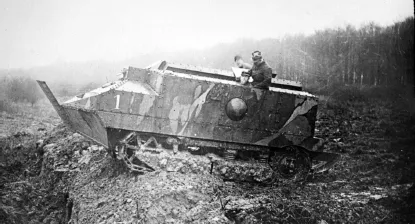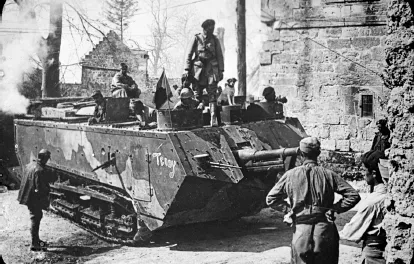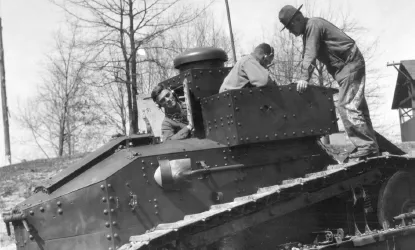![]()
CHAPTER 1
THE GREAT WAR OF 1914-18 AND THE BIRTH OF THE TANK
Tanks in common with all other auxiliary arms are but means of aiding infantry, on whom the fate of battle forever rests, to drive their bayonets into the bellies of the enemy.
Colonel George S. Patton, 1918
THE BRITISH WERE THE FIRST TO develop a functioning tank, but it was an idea whose time had come, and the French were close behind. All designs were directed toward solution of the strictly tactical problem of breaching German barbedwire defenses, but the tank doctrines of the two major Allied powers—France and England—diverged as the result of design innovations. A third Allied power, the United States, proposed a sound doctrine based on a combined-arms force built around tanks, but it entered the war too late and the concept would not come to fruition for two decades.
In the East, Imperial Russian attempts to design a functional combat vehicle failed through shortcomings of industrial technology, although designs ranged from the innovative to the bizarre. Of the Central Powers only Germany developed a functional tank, but their General Staff ignored tanks until it was too late. Their single serviceable tank design was poorly conceived, and coherent doctrine non-existent.
By October 1914, the fighting on the Western Front had stalled. British Lieutenant Colonel Ernest D. Swinton conceived the idea of an armored and armed vehicle based on the American Holt tractor that a friend had described as “a Yankee tractor which could climb like the devil.” Swinton’s concept was given the cold shoulder by the War Office, but caught the attention of the ambitious First Lord of the Admiralty, Winston Churchill. Churchill’s fleet was largely sitting idle, and he was anxious to somehow get his Royal Navy more involved in the land fighting.
The Landships Committee was established to develop a fighting vehicle, and it was this artifact that eventually created the name tank. In 1903, H. G. Wells had published The Land Ironclads that described large armored vehicles. This created something of a furor in the security services, so a code name had to be adopted. The story was spread that the box-like vehicles were water carriers for use in the Middle East. Unfortunately the abbreviation would be WC (British for a “water closet” or toilet) so “tank” was adopted instead.
Several early prototypes failed until William Tritton developed a drive system based on the American Bullock Creeping Grip Tractor. The prototype was christened Little Willie, a derogatory nickname for the German Crown Prince. A rotating gun turret was considered but quickly abandoned, as it raised the center of gravity with the risk of overturning. After Little Willie proved unsatisfactory, Lieutenant Walter G. Wilson suggested the rhomboid track frame characteristic of British tanks, with the track return passing up and over the top of the vehicle. The prototype was known as “His Majesty’s Landship Centipede” and “Big Willie” until the name “Mother” stuck.
After the Army belatedly became involved, naval influence declined, but naval terminology remained permanently attached to tanks: hull, turret, sponson, deck, bow, et cetera. Under the Army’s influence it was decided that a variety of armaments would be mounted for destroying enemy machine-gun positions. One problem was that the rhomboid design severely limited the fields of fire for weapons mounted in the hull. As a solution, armament was mounted in awkward sponsons that protruded from the sides, a feature then common for the secondary batteries on large warships.
Most British tank designs were the characteristic “rhomboid.” Designed for crossing trenches and obstacles, the design was far from practical in mobile warfare. The Germans were always lacking in sufficient numbers of tanks, and have pressed this captured British tank into service. (U.S.M.C. History Division)
British Tank Doctrine
For all their pioneering work in developing the first operational tanks, the British Army continued to perceive the tank as the solution to a specific tactical problem—breaching trench lines. Rather than massing tanks, they were typically allocated in small groups with seldom more than 30 vehicles—and often as few as eight—allocated to an army group. The postwar writings of J. F. C. Fuller, who was to become one of the leading advocates of armored warfare, reflect this strictly local tactical mindset.
Even the fundamental design features of British tanks reflected the trench-breaching doctrine, and the rhomboid design of most British tanks limited performance in open warfare.
The French Heavy Tank Program
The significance of the French tank program has been largely ignored. Jean-Baptiste Estienne was one of the shining lights of the French Army, and turned his fertile mind to the protection of infantry from machine-gun fire. In a staff presentation he predicted that “… the victory in this war will belong to which of the two belligerents which will be the first to place a gun of 75 [mm] on a vehicle able to be driven on all terrain.”
What Estienne was not aware of was that the French government was working at cross-purposes. Since May 1915 the Schneider Company was at work on a barbed-wire breaching vehicle. Sergeant Jacques Quellennec had seen men pointlessly slaughtered in the first battle of the Marne, and used his contacts—his father, engineer Edouard Quellennec, mechanic Charles Marius Fouche of the Service Automobile, and Eugene Brillie of the Schneider Company and designer of armored cars, to push forward his ideas for a tracked armored vehicle.
In early December 1915 Estienne and Philippe Pétain witnessed a test of the prototype of the new Schneider CA (later CA 1) tank. It was designed primarily for flattening barbed wire, with a secondary role to eliminate enemy machine-gun positions. Estienne immediately grasped the vehicle’s potential, and quickly had a more strategically decisive role in mind.
By mid-December Estienne had proposed formation of an armored force, and drawn up specifications for the vehicle’s capabilities, including that of towing an armored sled carrying 20 infantrymen. In late December Estienne met with industrialist Louis Renault, who declined any involvement, saying his firm was overcommitted to producing other vehicles.
Development continued until early 1916, when a dispute led Schneider and the French Army to part ways. Schneider went on to produce the Schneider CA heavy tank, clearly a derivative of the Holt, with a boxy armored body, a boat-like prow for crushing barbed wire, and a short-barreled 75-mm Blockhaus Schneider mounted in a barbette on the right side. The distinctive feature of the Schneider was a huge piece of angle iron protruding like a horn from the bow.
The original French heavy tanks were designed primarily for breaching wire obstacles. The prominent horn on the Schneider CA was to push higher wire down and under the tracks. (Association du Souvenir de Sommepy-Tahure)
There were improvements based on combat experience, and the redesign and conversion of older vehicles continued until the end of the war. The more prominent changes included spaced armor (two plates with an air space between) to defeat German armor-piercing rifle rounds. The internal fuel tanks turned the tank into a death trap when holed by German weapons, so the fuel tanks were moved to the rear and outside the main compartment. As with all tanks of the period the engine was located inside the crew compartment for ready access. A new ventilation system was provided, which meant that crews no longer began to succumb to carbon monoxide poisoning after about an hour of operation. Production of the Schneider was spotty, in part because effort was focussed on producing spare parts for existing vehicles, but largely because production capacity was diverted to artillery tractors.
A competing Army design became the St. Chamond, intended to upstage the Schneider by being larger and heavier. The new tank was designed around a specially designed Canon de 75-mm TR Saint Chamond mounted to fire through the bow plate, and four machine guns as opposed to the two of the Schneider. A 90 hp petrol engine generated power for two electric motors. The design made for much easier steering and more torque at low speeds, but could not remedy the fact that the vehicle was underpowered, and that the elongated bow limited trench-crossing capability.
When the new tank was tested in April 1916, major problems were the tank’s ergonomics. The driver sat high above the ground with his head and shoulders in a cupola on the left front roof. A second cupola blocked vision to the right, but worst of all, the isolated driver also functioned as tank commander, a ridiculous combination of responsibilities.
Estienne knew nothing about the competing designs. His elation at an order for 400 new heavy tanks turned to dismay when he learned the design details: “I am painfully surprised that an order of this importance has been placed without asking the opinion of the only officer who, at the time had undertaken a detailed study of the technical and military aspects involved….”
The St. Chamond heavy tank had a bow-mounted 75-mm field gun. The design, with two cupolas, severely limited the driver/tank commander’s vision to the right. (Association du Souvenir de Sommepy-Tahure)
Early use of the tank in combat revealed additional problems, and there were continuous modifications to the St. Chamond, particularly conversion to the standard French 75-mm field gun. A sloping roof was designed to counter the German tactic of throwing satchel charges onto the top, and elimination of the second cupola. But nothing could remedy the tank’s fundamental design flaws. In the final stages of the war the St. Chamond found its niche as an assault gun.
Although some of his design concepts were incorporated, Estienne played no role in the final technical development. He had instead turned his efforts to resolving the thousands of details necessary to bring the tank to maturity, from refining doctrine, to establishing training facilities, and assuring a flow of spare parts. His championship of the new idea and organizational skills earned him the title of the father of the French armored forces.
The French Light Tank Program
The tank idea planted in Louis Renault’s mind had continued to stir. Estienne and Renault met again on July 16, 1916 and Renault himself later drew up the basic specifications of a vehicle that would influence tank design for the next century. Then he unleashed his most talented design and production experts. The result was the revolutionary FT, for faible tonnage, or light tonnage. (The vehicle is often erroneously called the FT-17, a term that somehow became commonplace in the 1940s, but was never an official name.)
A doctrinal question soon arose as to whether a few heavy tanks were more effective than a swarm of the new Renault tanks, so Estienne at first expressed opposition to the new design. But on November 27, 1916, Estienne sent a memorandum recommending adoption of the Renault design.
Demand for the light tank to equip French, and later American, formations was so great that the vehicle was eventually produced by four manufacturers, including competitor Schneider. An American redesign, the M1918, included conversion to English measurements for details like bolts and screws, replacement of the large wooden front idler wheel with a steel one, and a more reliable Buda diesel engine. The latter feature allowed the addition of a much-appreciated firewall.
The FT was eventually exported to several countries, and in turn some were passed along to secondary users. Users eventually included Afghanistan, Belgium, Brazil, China, Czechoslovakia, Estonia, Finland, Nazi Germany, Iran, Japan, Lithuania, the Netherlands, the Philippines, Poland, Romania, White Russian forces and later the Soviet Union, Spain, Sweden, Switzerland, Turkey, the United Kingdom, and Yugoslavia. The M1918 was used by the United States Army and Marine Corps in the 1920s and 1930s, and by Canada as a training vehicle in World War II. Derivatives included the Italian Fiat 3000, Soviet “Russki Reno” (a blatant, unlicensed copy), and the Soviet T-18 with a redesigned suspension.
Communications and Evolving Doctrine
A serious problem was the lack of communications between vehicles. Crews were briefed on the mission, and thereafter might play follow the leader if the plan had to be adjusted on the fly. The only practical means of communication with other tanks was by colored signal flags or colored discs poked out a small signal hatch, semaphore masts mounted on the top of unit leaders’ tanks, or colored lamps. One-way communications to the rear were provided by human runners or homing pigeons, but most pigeons asphyxiated: for humans “the stay in the tanks mustn’t exceed 24 hours” stated a 1918 French report.
The various armies experimented with radios, but sets were bulky, easily damaged, and had only a short range. Two Schneider tanks were converted by addition of radios and 13-meter antenna masts. The Renault FT was too small to accommodate a radio, so a special variant, the TSF (Transmission sans fil) was introduced that replaced the turret with a large, boxy superstructure for the radio gear.
The specifications for the new Renault tank were that the vehicle would weigh no more than 7 tons so it could be transported by truck. A new engine was designed, and tracks would be automatically kept under the proper tension to avoid the thrown tracks that plagued so many tanks. The engine would draw cooling air through the crew space and exhaust it to the rear.
The greatest innovation of all was the general layout: the driver sat low and to the front with an excellent field of vision, the engine was to the rear, and a rotating turret gave the single turretmounted weapon a 360-degree field of fire. It would have only a single weapon, a Hotchkiss heavy machine gun, and in later versions a Puteaux 37-mm cannon. The only problems were that the crew comprised only two men, which meant that the vehicle commander/gunner/loader was overburdened, there was no firewall separating the crew space from the hot engine, and the engine was initially plagued by fan-belt problems. However the design proved so robust that it remained essentially unchanged except for a new welded turret that was simpler to produce than the original cast version.
The development of communications vehicles was being driven by an evolving doctrine. The arrival of the fast light British “cruiser tanks” like the Whippet and the French FT forced a major reconsideration of doctrine. Once the enemy front lines were breached, what was the role of the tank? Could the unique mobility of the tank make it a replacement for the cavalry? Estienne, like other tank visionaries, foresaw an overwhelming swarm of light tanks spearheading the exploitation phase of battle. If so, rapid and reliable communications would be required.
The first practical communications vehicle, the FT Transmission Sans Fils radio tank was unarmed, characterized by a fixed superstructure and a three-man crew. This American M1918 variant is identifiable by the large slid-steel front idler wheel. (U.S.M.C. History Division)
The German Effort
The German high command remained skeptical of the tank, even after encounters with British tanks. As a result, German tank design and production was too little and too late.
German designers seized upon the Holt artillery tractor as the chassis, and the rest of the design harkened back to Kaiser Wilhelm’s mobile fortress. The tall, lumbering A7V with its tiny tracks originally bristled with two cannons and four machine guns. The high profile would plague the vehicle; it was prone to overturning and indeed most losses resulted from such mishaps.
A re-design eliminated the rear-firing cannon, and the final armament was a single front-mounted 57-mm cannon and six machine guns. The 17–18-man crew was directed by an officer who sat, with the driver, in a roof cupola high above the ground with very poor vision to the front.
German design and production lagged behind the Allies, and Daimler did not deliver the first operational A7V Sturmpanzerwagen until October 1917. Germany produced a paltry 64 of these vehicles, and one was an unarmored Überlandwagen supply carrier. The A7V was always committed in limited numbers, with only five in its first action on March 21, 1918. That day only two actually saw action; the other three suffered mechanical breakdowns.
German efforts to develop larger and more modern designs never got beyond the prototype stage. Development of German tanks and a coherent doctrine for their use would eventually come from the lower ranks.
Imperial Russia
Designers in Russia quickly jumped on the armored vehicle des...





